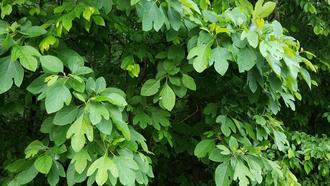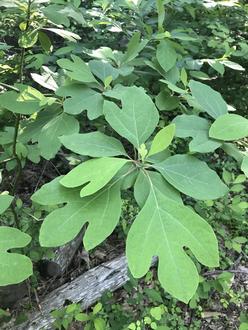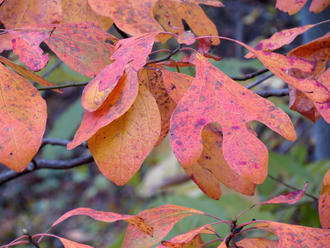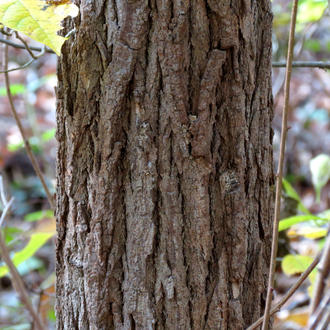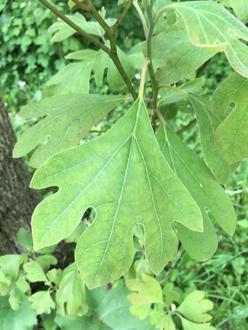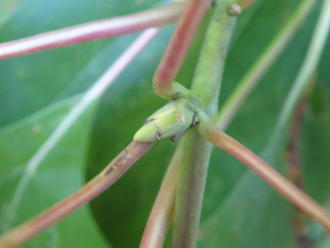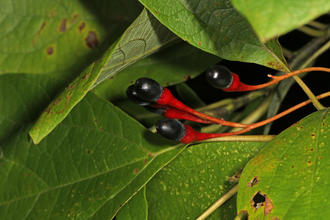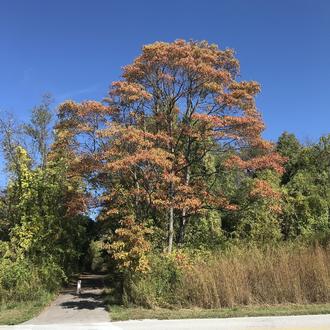Sassafras (Sassafras albidum (Nutt.) Nees)
Also known as white sassafras, red sassafras, silky sassafras, common sassafras.
↑Summary
A large shrub to medium tree with aromatic leaves and roots and variably-lobed leaves.
↑Description & Identification
A large shrub to medium tree, up to 98 feet (30 m) but usually much smaller. Height tends to be smaller towards the north of its range, on dry, sandy sites. Under such conditions maximum height is closer to 40 feet (12 m).
Leaves are variably lobed, and can be entire (unlobed), or with two lobes (mitten-shaped) or three-lobed, rarely with 4-5 lobes. Leaves and twigs are aromatic when crushed. Autumn color often proceeds through yellow to orange and reddish colors.
Sassafras is dioecious, with separate male and female plants. Fruit is a drupe that is dark blue, almost black, when ripe, borne in small clusters on bright purple-red pedicels.
The bark of mature trees is rugged and deeply furrowed, with irregularly-broken ridges.
The root system tends to be sparse, far-reaching, and relatively shallow, in the top 6-20 in (15-50 cm) of soil.
↑Similar Plants
↑Habitat
Occurs on a wide range of soil types in moist to dry conditions; grows best in open woodlands on moist, well-drained sandy loams, with pH of 6.0-7.0, but often more common on average to drier sites. Found on dry ridges and upper slopes, especially on sites that have burned recently. Tolerates acidic soils but intolerant of poorly-drained soils.
Most common in early-successional habitats, including abandoned fields, recently burned areas, gaps caused by windthrow, insect infestations (such as gypsy moths), and human disturbance. Often more common in fragmented forests, where it benefits from the higher-light conditions near the forest edge.
In some habitats, such as mixed hardwood-pine stands in Virginia, sassafras can establish and reproduce as an understory shrub, even when it is not able to survive to tree height due to insufficient moisture.
Sassafras tends to be more likely in habitats subjected to fire, particularly, more severe, high-intensity fire, which facilitates its establishment.
↑Life Cycle
Seedlings quickly establish a deep taproot. The large seeds of this species, with ample stored nutrients, allow it to establish readily on sites with low nutrient availability. Seedlings are able to establish in relatively low light conditions, and in deep leaf litter, and among competing vegetation. However, seedlings do not survive to maturity unless they are exposed to higher light conditions.
As trees develop, the root system develops mostly laterally.
Trees usually begin flowering at around 10 years of age, with peak seed production occurring 25 to 50 years. Male and female flowers are borne on separate trees. Good seed groups occur either every year or every other year.
Seeds ripen in the fall, and are distributed by birds, mammals, and to some degree by water. A small number of seeds germinate immediately, but most remain dormant through the winter and sprout the following spring. Germination rates are high.
Mature trees have moderate resistance to fire, with a thick, well-insulated bark.
If trees are top-killed, which can occur due to logging, severe fire, or drought, trees resprout from the root system and/or stump. Such vegetative regeneration is common in wooded areas with too much shade for seedlings to easily establish.
↑Faunal Associations
Birds, and to a lesser degree, mammals, eat the fruit, and in doing so help distribute seeds.
Flowers are insect-pollinated, and attract a variety of small bees and flies, occasionally wasps or beetles.
Larvae of the spicebush swallowtail, Papilio troilus, and the tiger swallowtail Papilio glaucus, eat the foliage of this and other related plants. Several moths also eat this species.
Mammalian herbivores, including rabbits and deer, browse this species to a limited extent when it is low enough to be within their reach.
↑Uses
This species is infrequently used in landscaping. It is generally considered an attractive plant, and is well-suited to all but the wettest or shadiest sites. However, its use is limited by its difficulty of transplanting, and its tendency to form root suckers, which either requires repeated pruning to remove sprouts, or allowing the plant to grow into a thicket with multiple stems.
Sassafras was historically used to brew an herbal tea, and as a flavoring, including in root beer. However, its use was banned in the U.S. in 1960 as a result of the banning of food additives containing safrole, the principle component of its essential oil, in response to evidence that safrole is carcinogenic.
↑Related Plants
There are at least two other species of the Sassafras genus globally, but no others in North America. Another species, Sassafras hesperia, is extinct and documented in the fossil record.
In the broader Lauraceae family, there are many related plants overlapping with the range of Sassafras; of these, northern spicebush (Lindera benzoin) (along with two other Lindera species) are closely related and share similar arormatic compounds, and many insects are adapted to eat both plants.
↑Links & External Resources
• Sassafras | The Wood Database (About This Site)
• Sassafras | Fire Effects Information System (FEIS) (About This Site)
• Sassafras albidum (Sassafras) | Illinois Wildflowers (About This Site)
• Sassafras albidum (Sassafras) | USDA PLANTS Database (About This Site)
• Sassafras albidum | Go Botany (About This Site)
• Sassafras albidum (Sassafras) | Missouri Botanical Garden Plant Finder (About This Site)
• Sassafras | Virginia Tech Dendrology Factsheets (About This Site)
• Sassafras | Silvics of North America (About This Site)
• Sassafras albidum | Biota of North America Project (BONAP) (About This Site)
• Sassafras albidum | NatureServe Explorer (About This Site)
• Sassafras albidum | Flora of North America (About This Site)
• Sassafras albidum | Missouri Plants (About This Site)
• Sassafras | Maryland Biodiversity Project (About This Site)
• Sassafras albidum (Nutt.) Nees (Sassafras) | Digital Atlas of the Virginia Flora (About This Site)





